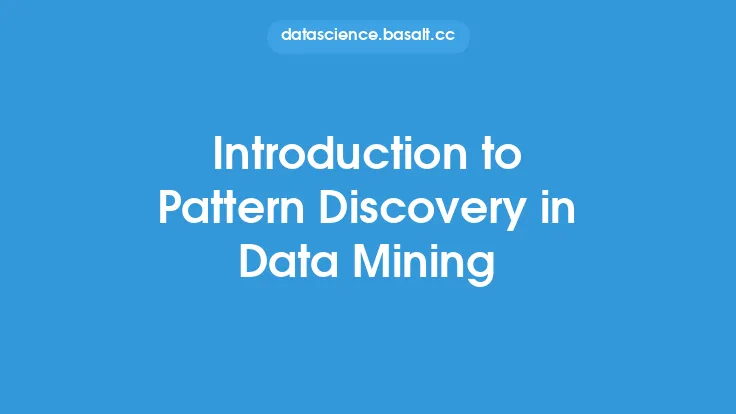Pattern discovery is a crucial aspect of data mining, which involves identifying meaningful patterns, relationships, and trends within large datasets. At the heart of pattern discovery lies a range of algorithms designed to uncover these hidden insights. This article delves into the world of pattern discovery algorithms, exploring their types, functionalities, and applications.
Introduction to Pattern Discovery Algorithms
Pattern discovery algorithms are the backbone of data mining, enabling the extraction of valuable knowledge from data. These algorithms can be broadly categorized into several types, including association rule mining, clustering, classification, and regression. Each type of algorithm is designed to address specific pattern discovery tasks, such as identifying relationships between variables, grouping similar data points, or predicting outcomes based on historical data. The choice of algorithm depends on the nature of the data, the problem being addressed, and the desired outcome.
Types of Pattern Discovery Algorithms
Association rule mining algorithms are used to identify relationships between variables in a dataset. These algorithms, such as Apriori and Eclat, work by generating rules that describe the co-occurrence of items or events. For instance, a retail company might use association rule mining to identify products that are frequently purchased together, allowing for targeted marketing and promotional campaigns. Clustering algorithms, on the other hand, group similar data points into clusters, enabling the identification of patterns and structures within the data. K-means and hierarchical clustering are popular examples of clustering algorithms.
Classification algorithms are used to predict a categorical outcome based on input features. Decision trees, random forests, and support vector machines are commonly used classification algorithms. These algorithms are widely applied in areas such as credit risk assessment, medical diagnosis, and customer segmentation. Regression algorithms, including linear and logistic regression, are used to predict continuous outcomes. These algorithms are often used in forecasting and prediction tasks, such as predicting stock prices or energy demand.
Algorithmic Techniques for Pattern Discovery
Several algorithmic techniques are used in pattern discovery, including decision tree induction, neural networks, and genetic algorithms. Decision tree induction involves constructing a tree-like model of decisions and their possible consequences. This technique is useful for handling large datasets and identifying complex relationships between variables. Neural networks, inspired by the structure and function of the human brain, are composed of layers of interconnected nodes or "neurons." These networks can learn complex patterns in data and are often used in image and speech recognition tasks.
Genetic algorithms, inspired by the process of natural selection, use principles of evolution to search for optimal solutions. These algorithms are useful for solving complex optimization problems and can be applied to a wide range of pattern discovery tasks. Other techniques, such as gradient boosting and deep learning, are also used in pattern discovery. Gradient boosting involves combining multiple weak models to create a strong predictive model, while deep learning involves the use of neural networks with multiple layers to learn complex patterns in data.
Evaluation Metrics for Pattern Discovery Algorithms
Evaluating the performance of pattern discovery algorithms is crucial to ensure that the discovered patterns are accurate and meaningful. Several evaluation metrics are used, including accuracy, precision, recall, and F1 score. Accuracy measures the proportion of correctly classified instances, while precision measures the proportion of true positives among all positive predictions. Recall measures the proportion of true positives among all actual positive instances, and F1 score is the harmonic mean of precision and recall.
Other evaluation metrics, such as mean squared error and R-squared, are used for regression tasks. Mean squared error measures the average squared difference between predicted and actual values, while R-squared measures the proportion of variance in the dependent variable that is predictable from the independent variable(s). The choice of evaluation metric depends on the specific problem and the desired outcome.
Challenges and Limitations of Pattern Discovery Algorithms
Despite the power of pattern discovery algorithms, several challenges and limitations exist. One of the main challenges is the presence of noise and missing values in the data, which can affect the accuracy of the discovered patterns. Another challenge is the curse of dimensionality, which occurs when the number of features or variables is very large. This can lead to overfitting and poor generalization performance.
Overfitting occurs when a model is too complex and fits the training data too closely, resulting in poor performance on new, unseen data. Underfitting, on the other hand, occurs when a model is too simple and fails to capture the underlying patterns in the data. Regularization techniques, such as L1 and L2 regularization, can be used to prevent overfitting. Other challenges, such as class imbalance and concept drift, can also affect the performance of pattern discovery algorithms.
Real-World Applications of Pattern Discovery Algorithms
Pattern discovery algorithms have numerous real-world applications, including customer segmentation, credit risk assessment, and medical diagnosis. In customer segmentation, pattern discovery algorithms can be used to identify groups of customers with similar characteristics and behaviors. This information can be used to develop targeted marketing campaigns and improve customer satisfaction.
In credit risk assessment, pattern discovery algorithms can be used to identify factors that contribute to credit risk and predict the likelihood of default. This information can be used to make informed lending decisions and minimize risk. In medical diagnosis, pattern discovery algorithms can be used to identify patterns in medical images and patient data, enabling the early detection and diagnosis of diseases.
Conclusion
Pattern discovery algorithms are a crucial component of data mining, enabling the extraction of valuable insights and knowledge from large datasets. These algorithms can be used to identify relationships, group similar data points, and predict outcomes. Despite the challenges and limitations, pattern discovery algorithms have numerous real-world applications and continue to play a vital role in driving business decision-making and improving outcomes in various fields. As data continues to grow in size and complexity, the development of new and more sophisticated pattern discovery algorithms will be essential to unlock the full potential of data mining.





